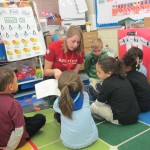“As we piece together what the new normal might look like in our high schools, we should take advantage of this disruption to reconfigure the many moving parts that have been used as excuses for maintaining the status quo,” says Michele Back, an assistant professor of secondary and world languages education in UConn’s Neag School of Education.
“We need to get ahead of this crisis to survive and thrive together. It is time to provide alternate options in education preparation so we can continue to prepare high-quality leaders and teachers within this ‘new normal,'” says Patricia Virella, a Ph.D. student at the Neag School and faculty member at Sarah Lawrence College’s Art of Teaching Program.
Students need to feel safe and have supportive relationships for their social, emotional, and academic learning to be optimized. Students experiencing trauma, such as from public health crises, weather disasters, or other upsetting events, may have been exposed to unpredictable schedules, inconsistent supervision, or food insecurity and desperately need school to be their safest, most predictable, and most positive setting, especially if they have been displaced or are without utilities or basic comforts.
University of Connecticut psychology professor James C. Kaufman, an expert in creativity research, in a Psychology Today post, sees people sheltering in place exhibiting “an increase in everyday creativity.” Although he lists a hierarchy of creative achievements, from “the family singing a song from ‘Les Miserables’” to publishing a “book about kiwi cultivation,…it is important not to let such a comparison diminish their value.”
Juanyi Li’s parents planned to fly from their hometown of Kunming, China, to Connecticut to watch her graduate. They had never been to campus and Li was eager to show them what life is like on an American college campus. “They made plans, but they had to cancel them,” Li said. “I started to plan my graduation a year ago. But it’s all canceled now.”
“We all are learning to adapt, but, this is not what we asked for, and we do not plan to continue when it is no longer required,” writes Tamika La Salle, an associate professor of school psychology at the University of Connecticut’s Neag School of Education and a research scientist at its Center for Behavioral Educational Research.
WNPR – audio 5:53 (Jennie Weiner is interviewed about the challenges of parenting and working online during the pandemic)
The University had originally planned to conduct remote learning for two weeks following spring break, but growing health concerns led to a fully online transition for the Spring 2020 semester. UConn faculty members, some of whom had never administered remote courses before, had to transition their coursework quickly to align with the new remote teaching style. Neag School alumna Karen Skudlarek ’88 (BUS), ’16 MA and her colleagues at CETL have been instrumental in the process.
With the recent transition from educating in the classroom to the virtual realm due to the pandemic, the teaching world has changed drastically. We wanted to hear from Neag School alumni now serving as teachers about how they are managing the online teaching and learning environment.
“I am proposing … that we need to adopt a different approach to school and curriculum during the three or four months this lasts,” says Elena Sada, a doctoral student in curriculum and instruction at the Neag School.



